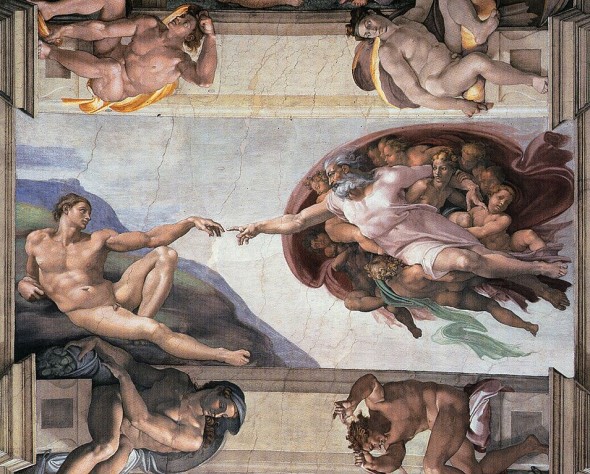
Michelangelo, Creation of Adam, from the ceiling of the Sistine Chapel in the Vatican, Rome, 1508-1512, fresco
The most famous section of the Sistine Chapel ceiling is Michelangelo’s Creation of Adam. This scene is located next to the Creation of Eve, which is the panel at the center of the room, and the Congregation of the Waters, which is closer to the altar.
The Creation of Adam differs from typical Creation scenes painted up until that time. Here, two figures dominate the scene: God on the right, and 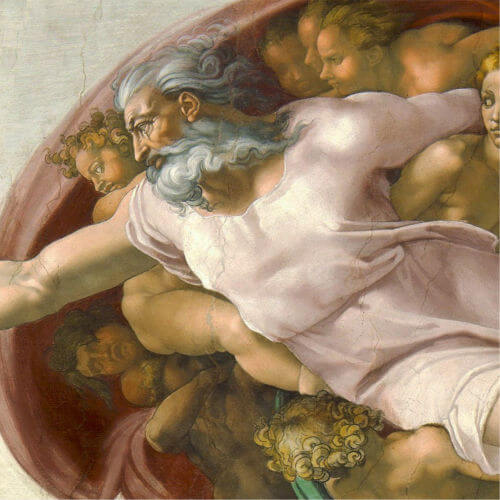 Adam on the left. God is shown inside a floating nebulous form made up of drapery and other figures. The form is supported on angels who fly without wings, but whose flight is made clear by the drapery which whips out from underneath them. God is depicted as an elderly, yet muscular, man with grey hair and a long beard which react to the forward movement of flight. This is a far cry from imperial images of God that had otherwise been created in the West dating back to the time of late antiquity. Rather than wearing royal garments and depicted as an all-powerful ruler, he wears only a light tunic which leaves much of his arms and legs exposed. One might say this is a much more intimate portrait of God because he is shown in a state that is not untouchable and remote from Man, but one which is accessible to him.
Adam on the left. God is shown inside a floating nebulous form made up of drapery and other figures. The form is supported on angels who fly without wings, but whose flight is made clear by the drapery which whips out from underneath them. God is depicted as an elderly, yet muscular, man with grey hair and a long beard which react to the forward movement of flight. This is a far cry from imperial images of God that had otherwise been created in the West dating back to the time of late antiquity. Rather than wearing royal garments and depicted as an all-powerful ruler, he wears only a light tunic which leaves much of his arms and legs exposed. One might say this is a much more intimate portrait of God because he is shown in a state that is not untouchable and remote from Man, but one which is accessible to him.
Unlike the figure of God, who is outstretched and aloft, Adam is depicted as a lounging figure who rather lackadaisically responds to God’s imminent touch. This touch will not only give life to Adam, but will give life to all mankind. It is, therefore, the birth of the human race. Adam’s body forms a concave shape which echoes the form of God’s body, which is in a convex posture inside the nebulous, floating form. This correspondence of one form to the other seems to underscore the larger idea of Man corresponding to God; that is, it seems to reflect the idea that Man has been created in the image and likeness of God – an idea with which Michelangelo had to have been familiar.
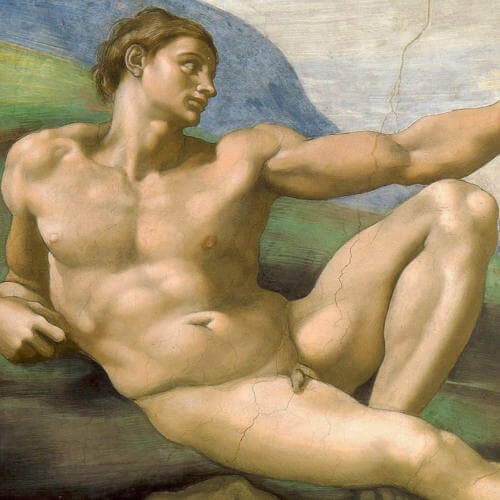 One of the questions that has been raised about this scene is the identity of the figures next to God. Given her privileged placement under the arm of God, the female figure is presumably an important one. Traditionally, she has been thought to be Eve, the future wife of Adam, who waits to the side until she is created out of Adam’s rib. More recently, however, a theory has been floated that this is actually the Virgin Mary, who takes this place of honor next to God and the child next to her, who would therefore be the Christ Child. This view is supported by the placement of God’s fingers on the child – the same fingers that the priest would use to raise the Eucharist during the Mass. Since Catholic theology holds that the Eucharist is the Body of Christ, this theological understanding would be embodied in this painting. If this latter interpretation is correct, the Creation of Adam would be intrinsically linked to the future coming of Christ, who comes to reconcile man after the sin of Adam.
One of the questions that has been raised about this scene is the identity of the figures next to God. Given her privileged placement under the arm of God, the female figure is presumably an important one. Traditionally, she has been thought to be Eve, the future wife of Adam, who waits to the side until she is created out of Adam’s rib. More recently, however, a theory has been floated that this is actually the Virgin Mary, who takes this place of honor next to God and the child next to her, who would therefore be the Christ Child. This view is supported by the placement of God’s fingers on the child – the same fingers that the priest would use to raise the Eucharist during the Mass. Since Catholic theology holds that the Eucharist is the Body of Christ, this theological understanding would be embodied in this painting. If this latter interpretation is correct, the Creation of Adam would be intrinsically linked to the future coming of Christ, who comes to reconcile man after the sin of Adam.
In all, the painting shows several hallmarks of Michelangelo’s painting style: the lounging 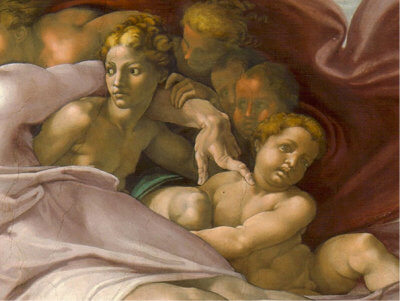 position of both Adam and God, the use of bodies which are both muscular and twisting, and the painting of figures who come across as works of sculpture. It is good to remember that Michelangelo was, after all, a sculptor. Painting was not his primary area.
position of both Adam and God, the use of bodies which are both muscular and twisting, and the painting of figures who come across as works of sculpture. It is good to remember that Michelangelo was, after all, a sculptor. Painting was not his primary area.
The Creation of Adam is one of the great jewels of Western art, though it and the rest of the Sistine Chapel ceiling suffered the ill effects of centuries of smoke that had caused the ceiling to darken considerably. It was not until 1977 that the cleaning of the ceiling was begun. The result of the cleaning was astonishing after its completion in 1989; what was once dark and drab became vivid. The change from pre-cleaning to post-cleaning was so great that some initially refused to believe that this is the way Michelangelo actually painted. Today, we have a much better understanding of Michelangelo’s palette and the world he painted, beautifully captured across the ceiling of the Sistine Chapel.
Further Reading
The Sistine Chapel (Michelangelo: Selected Scholarship in English), edited by William Wallace
Steinberg, Leo. “Who’s Who in Michelangelo’s Creation of Adam: A Chronology of the Picture’s Reluctant Self-Revelation.” Art Bulletin (1992): 552-566.
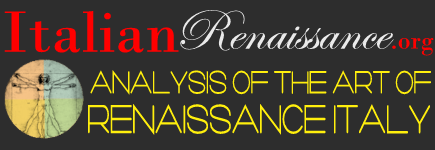

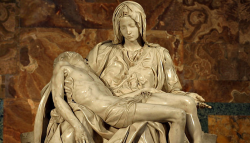
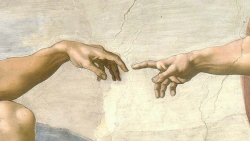
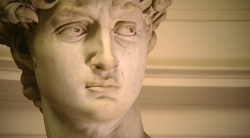
An article Bruce Sutherland has written was published in winter 2013 issue of “Source: Notes in the History of Art” stating that Michelangelo’s source of inspiration for the figure of Adam was an ancient Roman cameo showing a nude Augustus Caesar riding sidesaddle on a Capricorn. The cameo is in Alnwick Castle, Northumberland. Usually the cameo can be seen by typing “Augustus, cameo, Capricorn” on Google Image.
I have also determined the probable sources for the figures of Eve and God, but I have not yet had this article published.
Hi, I just read your post. It is true that the woman under god’s arm is virgin Mary. I did upload some videos on YouTube to support this. My username on YouTube is AMWELL128. IF you type that name in, you’ll see my five videos of this painting. Video 2 shows her identity.
The True meaning of Creation of Adam, is that Adam Created God, God Being the Creation. The remaining Mystery is where did Adam come from?
Instead of the red backdrop that is behind God, being a brain, I believe that it’s a heart. God didn’t try being evil by keeping intelligence from Adam. Instead as God is a creator, a being of good, I feel the red backdrop is more realistic.
I would love to give this beautiful piece of Art to the Bacilica Church in Asheville, NC.
In her commentary on Proverbs-Ecclesiastes-Song of Songs, Ellen Davis suggests that the verbal portrait of Wisdom may have inspired the female figure under discussion:
‘In the famous scene where the spark of life passes from God’s finger to Adam’s, there appears at God’s side a lovely young woman with eyes alert, her knee bent, poised for action. God’s “non-creating” hand is thrown around her shoulders in a casual but intimate gesture. The woman is sometimes identified as Eve, but the contrast between her strong but delicate beauty and the coarse figure of Michelangelo’s Eve is pronounced. It is far more likely that this, the most convincingly feminine portrait he ever painted (his other female figures seem to be male bodies with enlarged breasts), is Wisdom the “master worker” (the translation is debated; other possibilities are “darling, ward”), sharing God’s excitement and delight in the fresh new world and its inhabitants.’